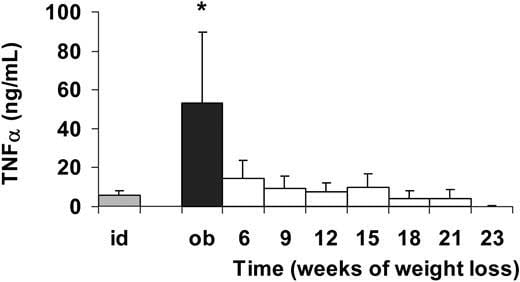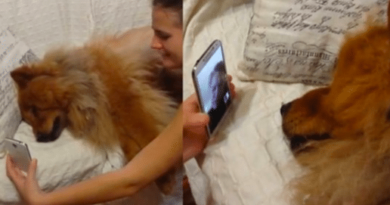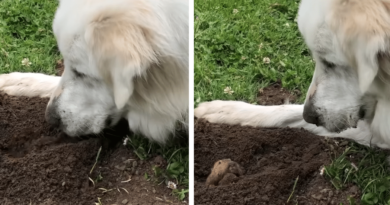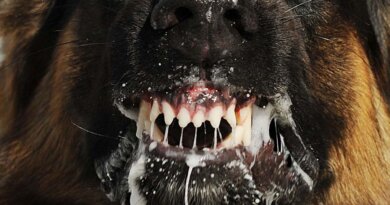How to Slim Down an Overweight Dog [30-Day Diet Plan]
[ad_1]
Dog obesity is a rapidly growing health problem. Obese dogs will suffer from breathing issues, diabetes, arthritis, and joint pain (1). This article discusses the importance of weight loss, and several ways of how to slim down an overweight dog.
The good news is that a dog’s weight management is in your control (2). If you currently have an overweight dog, you’ll have to go through two phases: weight loss and weight management. A switch to a different, preferably weight loss dog food brand, may be necessary to reduce energy intake. In extreme cases, two different types of drugs can be used: dirlotapide and mitratapide (3, 4).
Other than calorie restriction, certain composition of foods was shown in studies to improve weight loss for dogs (5). For example, high protein pet foods provided the best results (6). Such diets, paired with smaller caloric intake and addition of exercise were extremely effective (7, 8). Based on these and other studies, my below guide on how to lose weight for obese dogs will lay out for you a step by step plan.
How Excess Weight Affects Your Dog
A dog’s body is built to carry only a certain amount of weight and any extra places higher demands on both the organs and the skeletal system (9). One of the problems is that pet owners incorrectly assess their pets’ weight and body condition. More recent studies show that proper assessment can increase lifespan in dogs, and lead to better overall health.
As veterinarians, we have seen an increase in number of obese pets (10, 11). In my practice I often deal with pet owners who are looking for advice on how to slim down an overweight dog. Most common health issues caused by excess weight include those mentioned below (12, 13, 14, 15).
- Diabetes is one of the most prevalent conditions found in overweight dogs. The production of insulin is increased because there is a higher glucose level in the blood, and if the demand continues to increase over a long time, the pancreas (responsible for the production of insulin) fails to keep up and may eventually give out. The result is diabetes.
- Increased blood pressure is common in overweight dogs, just as it is in overweight people. The heart has to work harder to pump blood to the extra tissue, which may eventually lead to heart failure.
- Birthing issues are also not uncommon. An overweight bitch is much more likely to require veterinary assistance while birthing, with the high possibility of a C-section birth.
- Digestive disorders including constipation and flatulence are not at all pleasant for dog or owner and are often a problem with overweight pets.
- Breathing difficulties are likely to develop as the body struggles to inflate the diaphragm encumbered with extra fat. Obviously, the extra weight also puts more strain on the body, as the lungs have to supply oxygen – the result of breathing difficulties may be respiratory disease.
- Damage to bones, joints and ligaments is also likely if the skeletal frame is subject to more load than that for which it is designed. Studies have shown that 25% of dogs that are overweight suffer from severe joint complications. Osteoarthritis is just one of such complications.
- A dog with a bad heart or lungs due to excess weight may also experience problems associated with anesthetics and/or surgery procedure that’s due for other health reasons.
An overweight dog will also have a decreased lifespan and are at higher risk of sudden death (16).
In short, obese dogs will require more costly veterinary care, aren’t going to lead an active and enjoyable life and cannot be expected to live as long as dogs at optimum weight.
How Do I Asses My Dog’s Weight?
It is best to ask your veterinarian for expert advice on the ideal weight for your dog; however, as a starting point, it is not difficult to get a reasonable idea of your pet’s weight by using a BCS chart (Body Condition Score, see on the right) and making a simple physical examination yourself.
A dog in good condition should have a slightly ‘hour-glass’ shaped figure below the ribs. Feel along the chest – if you can easily feel the ribs down the side of the chest, then there is obviously no extra fat on them. You should be able to distinguish between the animal’s rib cage and his abdomen, and the latter should taper in slightly.
If you can’t feel the ribs, the waist is flat or looks bloated or the stomach is dragging when he walks, then it’s time for a bit of change in your dog’s lifestyle and eating habits.
Studies show that there are certain risk factors that may cause your dog to be at a higher risk of obesity. These can include his breed, his diet, his age and whether or not he is neutered. If your dog falls into a higher risk category, it is most important that you stay on top of his physical condition.
Weight Loss Dog Diets – Where Do You Start?
You have determined that your dog is overweight, so now what? Before you embark on any type of diet, consult your veterinarian and discuss your weight loss treatment options.
Be sure that your pet is not suffering from any type of medical ailment that is causing the weight gain. Too many dogs are put onto a diet and down the road their owners find out that disease, not a wrong diet, was the cause of their weight gain.
The daily caloric needs of your pet will vary according to his age, stage of life and daily activities. Factors such as pregnancy will also increase the daily needs. Your vet will also be able to advise you as to the correct daily caloric intake for your pregnant dog.
Armed with the knowledge of how many calories your dog needs in a day, and a few weight loss dog food brands in your cupboard, take an objective view at the food that your dog is going to be consuming, calorie-wise. Don’t forget about the extra treats you give him for good behavior. Treats should really only comprise about 5% of his total caloric intake during weight loss plan.
Some of the best vet recommended dog food brands for weight loss and weight maintenance are:
Time to Take Action – Some Helpful Tips
Implementing a new weight loss diet for the dog must be done sensibly and gradually. You can’t simply decide to halve the amount today that you fed your pet yesterday. Any diet must be complimented by a sustainable exercise program; slow and steady wins the race, not a strenuous hike today and nothing for the rest of the week. Below are a few general tips which you may find helpful.
- Start a meal/food diary for your dog. Record how much he eats and tally up the caloric intake.
- A high protein diet is necessary for dogs, so don’t try and eliminate all fat, simply reduce the amount. It is also really important to remember that there are different kinds of fats – some ‘good’ and some ‘bad’. Fish oil, flax-seed oil and foods containing omega 3 are good for both humans and dogs, in contrast to trans-fat and animal fats that may be contained in many of your pet’s favorite treats and cookies.
- Remove separable fat from meat portions and try to avoid obviously fatty meats such as pork and lamb. That’s how low fat dog food brands are made. Yourself, try cooking meat before serving so that you can separate as much of the fat as possible.
- Prepare healthy alternatives to biscuit or cookie snacks and have them readily on hand. Such snacks may include fruit, vegetables and other unprocessed foods.
- If you have more than one dog in the house, stealing from other pet’s bowls may be a serious issue that will have to be stopped. This problem is likely to increase if one of your dogs is on a restricted diet, so be very watchful and don’t leave bowls of food lying around.
- If you are expecting visitors, take the initiative and reduce the amount you feed prior to a visitor’s arrival – it is inevitable that your guests will hand out an extra treat or food scrap of some sort.
- Garlic, though not good for the breath, is not toxic to dogs in small amounts and is a natural weight-loss assistant. Try crushing a small amount of garlic into your dog’s food bowl, although if your dog has not been used to it, do not do this every day.
- Dogs are by no means stupid and they know how best to make us feel bad about not feeding them when they want it. You will need to totally ignore any whining or begging that your canine companion resorts to – these are ‘sympathy’ tactics that your dog knows will melt your heart. By paying no attention to this behavior, your pet will learn that pushy and demanding actions are no longer acceptable and that he will have to calm down before the meal will be given out.
- Does your dog gobble and eat too fast? Try and slow him down. How about smearing the food around the sides of the dish so that he has to lick harder to get it all out? You can also try using a slow feeder – there are many options available and they are usually very affordable.
- Many commercial foods lack sufficient nutrients and the result is that the dog is always craving more. Now might be just the time to upgrade to a premium food, so that your pet is satisfied with less.
- How about reducing the amount of bought foodstuffs you hand out and complimenting the diet with healthy home-made alternatives? There are plenty of recipes available online to help you create exactly what your pet needs, with the assurance that you know exactly what is going into it.
- Talk to other family members and friends about the diet plan you are implementing for your dog and ensure that they too understand that it is no longer acceptable to hand out table scraps and extra treats.
- Ensure that the garbage cans are no longer accessible – if your pet is feeling hungry it is much more likely to resort to such undesirable food sources.
- There are many dog food options which are labelled ‘lite’ or ‘diet’ – thoroughly read the ingredients list and calorie intake per serving, as these may not necessarily be the best meal option. Many of these types of diet foods substitute meat content with higher volumes of carbohydrates so that, while they may make the animal feel fuller, the effect will not last long and it may have the side-effect of increasing stool production.
Another way to aid weight loss is to try cutting back on the regular dog food and adding some vegetables instead. Fresh vegetables are an excellent source of fiber and vitamins and will add variety to the diet too, and they’re low in calories. Some excellent options include: Broccoli, Apples, Celery, Cucumber, Carrots, Bananas, Whole grains (oats, brown rice, millet, served with a tbsp. olive or sesame oil), and Green beans.
Exercise as Foundation for a Dog’s Weight Loss
Any successful diet must be complimented by a sustainable and suitable exercise program. Reduced calories alone may go a certain way towards weight loss, but another major part of dieting is muscle toning, which is a result of using and strengthening the muscles which have been ‘on holiday’, so to speak.
While the actual daily food intake part of the diet may be a little complicated and require some detailed calculations, the exercise part is something enjoyable to both man and beast. Exercising with your dog is fun for both of you and easy enough to fit into your daily routine.
Some simple examples are:
- A walk around the block or several blocks
- Frisbee or fetch with a new toy
- Social ‘off-leash’ time in a dog park
- Swimming
- Tug-of-war or catch games
You may well find that increased exercise will help you achieve your personal weight goals too.Again, it is best to consult professional advice before launching an exercise program. Very overweight dogs may need time to build up the necessary stamina to maintain rigorous physical exercise. Like humans, your dog will be exhausted after the first few times of extended play, but don’t lose heart – in time he will build up their strength and endurance and be able to sustain it going forward.
How to Slim Down an Overweight Dog
The 30 Day Plan
Today is D-day. There is no better time to get moving and cut back on eating! I cannot stress enough the importance of consulting your veterinary practitioner before launching a full-scale weight loss operation. So, if at all possible, book an appointment to have a thorough check-up of your dog, discuss the weight loss options and ask for any tips or advice relating specifically to your dog.
Week #1
Determine your pooch’s ideal daily calorie intake. In the absence of seeing a vet to determine this, the following formula/s might prove to be useful to you (calculation is done in pounds)
Divide your dog’s weight by 2.2, then multiply the result by 30 then add 70 [(lbs/2.2)x30]+70
This will give you a general idea of how much your dog should be eating if it is an indoor and inactive pet. Use this only as a guide, because the metabolic needs of each pet will vary.
Take your new meal/food diary and work out the calorie count of a typical day for your pet (i.e before you started the diet). Most good quality pet foods have comprehensive nutrition charts on the bag or tin. If you are feeding your pet dry or tinned foods, you can easily measure accordingly, however keep in mind that most commercial pet foods are measured using an 8oz cup measure – make sure you do the same.
If you are feeding a combination of bought and homemade foods, you will need to consult dietary charts or books for caloric information on the ingredients that go into the homemade portion of the diet and add up the total that is being served per portion. Consult the calorie charts below for calorie counts of common vegetables and fruits.
Compare the calorie count your dog has been consuming with what he/she needs. Decide where you are going to cut back.
Start the first by reducing your dog’s daily intake by just 25%. Then reduce it every two or three days by 10% (you will continue to do this until you are seeing a 1% loss per week). Don’t make drastic reductions all at once; we are aiming for gradual weight loss which can be sustained, not dramatic loss that is easily gained again.
You may find it easier to create a menu plan for the week – list out exactly what your dog will eat each day – don’t forget to allow for treats. Remember, as a rule of thumb, treats should comprise only 3 – 4% of the daily intake. Treats don’t necessarily have to be food; how about a new toy?
Create an exercise plan in conjunction with the menu plan. Try to incorporate some form of exercise each day. Just like people, if your pet has not been used to regular exercise, it will take time for him/her to get accustomed to it so start gently and increase the exertion level over time. An example of the first week might be:
- Monday: 20 minute gentle walk
- Tuesday: 15 minute ball-catching session
- Wednesday: 15 minute brisk walk
- Thursday: 25 minutes ‘off-leash’ time in the dog park
- Friday: Tug-of-war or Frisbee game for as long as he/she can sustain
- Saturday: 25 minutes brisk walk
- Sunday: Rest day
The term ‘brisk walk’ means a walk at a steady pace, without stopping for the dog to mark territory or sniff at scents. Hold the leash firmly and close and use obedience commands such as ‘come’ or ‘heel’ if the animal is inclined to try and stop.
Your dog needs to understand that you are on a mission and that this is not just the casual stroll that he may have been used to in the past. If your pooch refuses to co-operate you may have to resort to taking it back home, crating the animal or giving it no attention for a set length of time, then try again later in the day. Do not over-exert elderly dogs or those with poor health – again, it is best to consult your veterinary specialist in such circumstances.
Week #2
By now the honeymoon of the diet is over and your dog should have fully ‘switched over’ to the new diet menu and be getting accepting the fact that you are serious about the exercise program.
Be sure to do a weigh-in session and record your pooch’s progress. The ideal and safe weight loss is approximately 1% per week, however, if the progress isn’t that marked, don’t forget that the animal hasn’t been on the diet properly for even a full week.
Take time out to create a menu and exercise plan at the beginning of the week – it will save you the daily frustration of trying to work out serves and calories.
Depending on your own daily schedule, you may find it beneficial to break up mealtimes into several smaller ones. Remember, dogs aren’t mathematicians and making the meal portions smaller and more often may prove to be more satisfying and help curb any desires to scavenge.
Remove the food bowls after 30 minutes or so and discard uneaten portions. If you leave bowls around you are encouraging an ‘all day buffet’ rather than specific meal times.
Also, try incorporating a little exercise into the mealtime routine. Place the food in several different locations or, if your dog is an inside pet, at the top or bottom of a staircase. You will need to be creative in coming up with new ideas because overweight dogs are smart and if the meal time location moves up or downstairs, so will they!
Keep in mind that your dog may benefit from a little extra love and affection while on a strict diet. An extra cuddle or massage will re-assure him that you still love them and the restricted meals and lack of regular, unhealthy goodies does not mean that you have lost interest in him.
Keep working on the exercise program. It may seem very constant, but results may already be showing. Your pet should be starting to show signs of increased stamina and maybe you too are proving the benefits of daily exercise! Try incorporating a swim (weather permitting) into this week’s program – swimming is an excellent way of strengthening and toning nearly every muscle in the body.
Week #3
You should be starting to notice real changes now. With the constant exercise and healthy eating program your dog should be more active, more energetic and starting to lose that extra flab that didn’t look good.
Take time to record these changes in your diary. Take photos of your pooch and add them to your record.
However thrilling this change may be, please don’t resort to treating your dog because he/she is doing so well. Remember, you love your pet and you are doing the best for them, do don’t spoil it now!
Again, take time to plan out the week’s meals and exercise program and stick to it. By now, it will be seeming more natural and you will hopefully be adjusting your lifestyle around the extra activities.
Week #4
Weigh-in again and take time to enjoy the results of your efforts. Update your diary and take more photos. Share your excitement with your friends and family and treat your dog to an extra cuddle or favorite activity. Your dog should be looking much better, slimmer and generally healthier.
If your pet has reached its goal weight, you need to establish a maintenance diet. Talk to your vet about this, because maintenance programs are individual and vary wildly depending on the type of dog.
There is a tendency to relax on exercise once the optimum weight is reached, however this is a trap that you must take steps to avoid. Keep up the daily exercise – your dog will now be enjoying it and looking forward to these times, so don’t slacken off. After all, its quality time for them and you and can be turned into a whole family activity.
Don’t be disheartened if the goal weight hasn’t been achieved inside one month. Consider how long it has taken for the dog to become this overweight in the first place and accept that it is going to take a lot of effort and dedication to bring him/her back to what they should be.
“Rome wasn’t built in a day”. We hear that said often enough and it applies to dieting too. Just keep going, steadily moving forward. It may not be easy to see the daily improvement when you are with your pet all the time, but look back over a week, a month and enjoy the positive changes.
Your efforts will be well worthwhile when you consider that you are adding extra years to your dog’s life, not to mention a much better quality of life. Apart from the aches, pains and suffering you are saving your pooch, consider the savings you are making yourself on extra veterinary bills and prescribed medicines and treatments!
I think it really boils down to how much you love your pet – if you love them you will care for them in the way that is best for them, not by catering to their every whim and fancy and spoiling them with unnecessary and unhealthy treats.
READ NEXT: Ask a Vet – How to Put an Overweight Dog on a Diet?
Want to share this?
[ad_2]
Source link









